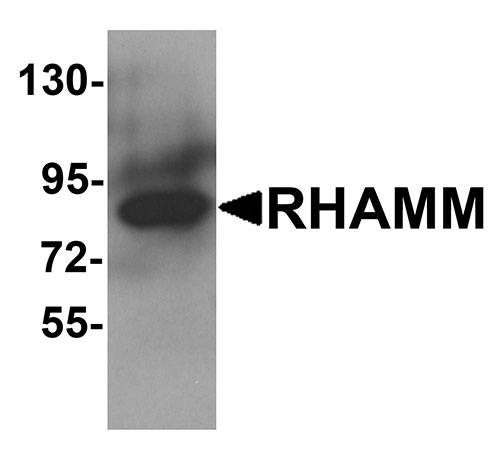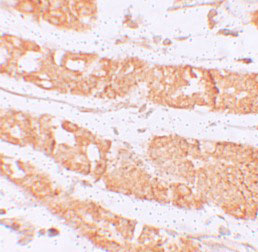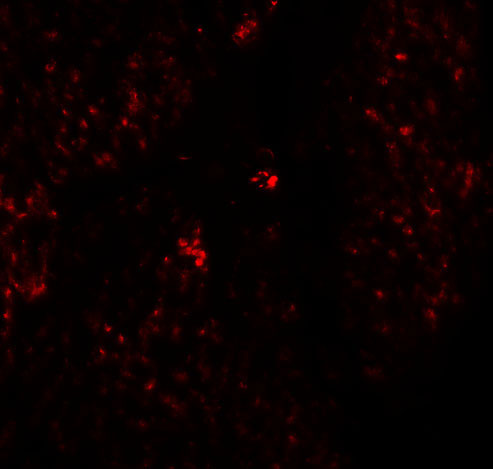RHAMM Antibody
- SPECIFICATION
- CITATIONS
- PROTOCOLS
- BACKGROUND

Application
| WB, IHC-P, IF, E |
|---|---|
| Primary Accession | O75330 |
| Other Accession | NP_036617, 217272802 |
| Reactivity | Human, Mouse, Rat |
| Host | Rabbit |
| Clonality | Polyclonal |
| Isotype | IgG |
| Calculated MW | 84100 Da |
| Application Notes | RHAMM antibody can be used for detection of RHAMM by Western blot at 1 µg/mL. Antibody can also be used for immunohistochemistry starting at 2.5 µg/mL. For immunofluorescence start at 5 µg/mL. |
| Gene ID | 3161 |
|---|---|
| Target/Specificity | HMMR; |
| Reconstitution & Storage | RHAMM antibody can be stored at 4℃ for three months and -20℃, stable for up to one year. As with all antibodies care should be taken to avoid repeated freeze thaw cycles. Antibodies should not be exposed to prolonged high temperatures. |
| Precautions | RHAMM Antibody is for research use only and not for use in diagnostic or therapeutic procedures. |
| Name | HMMR |
|---|---|
| Synonyms | IHABP, RHAMM |
| Function | Receptor for hyaluronic acid (HA) (By similarity). Involved in cell motility (By similarity). When hyaluronan binds to HMMR, the phosphorylation of a number of proteins, including PTK2/FAK1 occurs. May also be involved in cellular transformation and metastasis formation, and in regulating extracellular-regulated kinase (ERK) activity. May act as a regulator of adipogenisis (By similarity). |
| Cellular Location | Cell surface {ECO:0000250|UniProtKB:Q00547}. Cytoplasm {ECO:0000250|UniProtKB:Q00547}. Cytoplasm, cytoskeleton, spindle {ECO:0000250|UniProtKB:Q00547} |
| Tissue Location | Expressed in testis (PubMed:22965910). Expressed in the breast (PubMed:8890751). |

Thousands of laboratories across the world have published research that depended on the performance of antibodies from Abcepta to advance their research. Check out links to articles that cite our products in major peer-reviewed journals, organized by research category.
info@abcepta.com, and receive a free "I Love Antibodies" mug.
Provided below are standard protocols that you may find useful for product applications.
Background
RHAMM Antibody: The hyaluronan-mediated motility receptor, also known as RHAMM, was initially identified as a soluble protein that could be released by sub-confluent migrating cells, promoting cell motility and invasion via interactions with hyaluronan (HA) and the cell surface. While RHAMM is normally poorly expressed in most normal tissues and is not required for embryonic development or normal cell homeostasis functions, its expression is increased during wound repair in response to hypoxia and fibrogenic factors. However, its overexpression is transforming in multiple types of cancers and is required for maintaining RAS transformation. RHAMM associates with BRCA1 and BARD1, attenuating the mitotic-spindle-promoting activity of RHAMM, which may contribute to tumor progression by promoting genomic instability.
References
Hardwick C, Hoare K, Owens R, et al. Molecular cloning of a novel hyaluronan receptor that promotes tumor cell motility. J. Cell Biol. 1992; 117:1343-50.
Samuel SK, Hurta RA, Spearman MA, et al. TGF-beta 1 stimulation of cell locomotion utilizes the hyaluronan receptor RHAMM and hyaluronan. J. Cell Biol. 1993; 123:749-58.
Hall CL, Yang B, Yang X, et al. Overexpression of the hyaluronan receptor RHAMM is transforming and is also required for H-ras transformation. Cell 1995; 82:19-26.
Maxwell CA, McCarthy J, and Turley E. Cell-surface and mitotic-spindle RHAMM: moonlighting or dual oncogenic functions? J. Cell Sci. 2008; 121:925-32.
If you have used an Abcepta product and would like to share how it has performed, please click on the "Submit Review" button and provide the requested information. Our staff will examine and post your review and contact you if needed.
If you have any additional inquiries please email technical services at tech@abcepta.com.













 Foundational characteristics of cancer include proliferation, angiogenesis, migration, evasion of apoptosis, and cellular immortality. Find key markers for these cellular processes and antibodies to detect them.
Foundational characteristics of cancer include proliferation, angiogenesis, migration, evasion of apoptosis, and cellular immortality. Find key markers for these cellular processes and antibodies to detect them. The SUMOplot™ Analysis Program predicts and scores sumoylation sites in your protein. SUMOylation is a post-translational modification involved in various cellular processes, such as nuclear-cytosolic transport, transcriptional regulation, apoptosis, protein stability, response to stress, and progression through the cell cycle.
The SUMOplot™ Analysis Program predicts and scores sumoylation sites in your protein. SUMOylation is a post-translational modification involved in various cellular processes, such as nuclear-cytosolic transport, transcriptional regulation, apoptosis, protein stability, response to stress, and progression through the cell cycle. The Autophagy Receptor Motif Plotter predicts and scores autophagy receptor binding sites in your protein. Identifying proteins connected to this pathway is critical to understanding the role of autophagy in physiological as well as pathological processes such as development, differentiation, neurodegenerative diseases, stress, infection, and cancer.
The Autophagy Receptor Motif Plotter predicts and scores autophagy receptor binding sites in your protein. Identifying proteins connected to this pathway is critical to understanding the role of autophagy in physiological as well as pathological processes such as development, differentiation, neurodegenerative diseases, stress, infection, and cancer.




